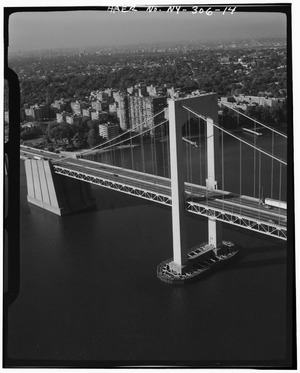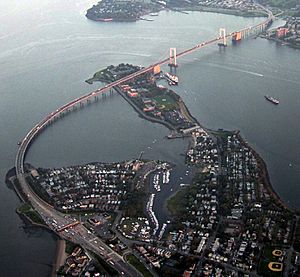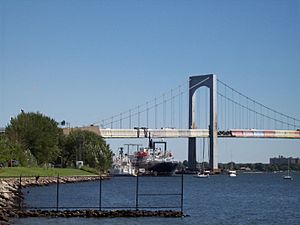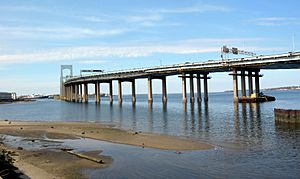Throgs Neck Bridge facts for kids
Quick facts for kids Throgs Neck Bridge |
|
|---|---|
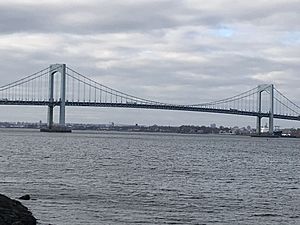
Throgs Neck Bridge from Fort Totten
|
|
| Coordinates | 40°48′07″N 73°47′35″W / 40.802°N 73.793°W |
| Carries | 6 lanes of |
| Crosses | East River |
| Locale | New York City (Throggs Neck, Bronx – Bay Terrace, Queens) |
| Maintained by | MTA Bridges and Tunnels |
| Characteristics | |
| Design | Suspension bridge |
| Total length | 2,910 feet (890 m) |
| Longest span | 1,800 feet (550 m) |
| Clearance below | 142 feet (43 m) |
| History | |
| Designer | Othmar Ammann |
| Construction cost | $92,000,000 |
| Opened | January 11, 1961 |
| Statistics | |
| Daily traffic | 119,249 (2016) |
| Toll | As of March 31, 2019[update]: $9.50 (Tolls by mail and non-New York E-ZPass); $6.12 (New York E-ZPass) |
The Throgs Neck Bridge is a suspension bridge in New York City. It carries six lanes of Interstate 295 (I-295) over the East River. This is where the river meets the Long Island Sound. The bridge connects the Throggs Neck area of the Bronx with the Bay Terrace area of Queens.
It opened on January 11, 1961. This makes it the newest bridge across the East River. It was built to help with traffic on the Bronx–Whitestone Bridge. That bridge is about 2 miles (3.2 km) to the west. The Throgs Neck Bridge is also the easternmost bridge over the East River. Because of its location, it is a good route from Long Island to New Jersey. It connects to the George Washington Bridge and other routes north.
The government of New York City owns the Throgs Neck Bridge. The Triborough Bridge and Tunnel Authority (TBTA) operates it. The TBTA is part of the Metropolitan Transportation Authority (MTA).
Contents
What is the Throgs Neck Bridge Like?
The Throgs Neck Bridge was designed by Othmar Ammann. He was a famous structural engineer. He also designed other New York City bridges. These include the George Washington Bridge, Bronx–Whitestone Bridge, Verrazzano-Narrows Bridge, and Triborough Bridge.
The Throgs Neck Bridge connects Queens in the south to the Bronx in the north. It is the third bridge for cars built between Queens and the Bronx. The other two are the Triborough and Bronx–Whitestone Bridges.
The bridge is a suspension bridge with six lanes. There are three lanes in each direction. Each set of three lanes is 37 feet (11 m) wide. A 4-foot-wide (1.2 m) barrier separates the two directions of traffic. The road is paved with asphalt. You cannot walk or bike on this bridge.
The Throgs Neck Bridge is a toll bridge. It used to have tollbooths on the Bronx side. But these were replaced in 2017. Now, it uses open road tolling.
How Was the Bridge Designed?
The Throgs Neck Bridge did not have many limits from ships. So, it did not need to be as long as other bridges designed by Ammann. The middle part of the bridge is 1,800 feet (550 m) long. The total length from one anchorage to the other is 2,910 feet (887 m).
The bridge has two long ramps leading up to it. One is on the Bronx side and one on the Queens side. This is because both areas are low to the ground. The Bronx ramp is 3,900-foot (1,200 m) long. It curves over the SUNY Maritime College. The Queens ramp is 2,800-foot (850 m) long. Including these ramps, the bridge is more than 2 miles (3.2 km) long.
Two main cables hold up the bridge deck. These cables are supported by tall suspension towers. Each main cable has 37 strands. Each strand is made of 296 wires. This means each main cable has 10,952 wires in total. The main cables weigh 1,790 short tons (1,600 long tons; 1,620 metric tons) each.
At each end of the suspension part are two anchorages. These are large concrete structures that hold the main cables. They are 250 by 350 feet (76 by 107 m) in size. The Bronx anchorage is at the tip of Throggs Neck. The Queens anchorage is near Fort Totten. The towers are in the middle of the Long Island Sound.
The suspension towers are made of closed boxes. They have arched supports at the top. The towers rise 326 feet (99 m) above their concrete islands. These islands are 20 feet (6.1 m) above the water. Peregrine falcons have lived on a suspension tower since 1983. They like the high towers because they look like tall cliffs.
Instead of a smooth design, Ammann used 28-foot-deep (8.5 m) trusses under the deck. These trusses act as counterweights. They also let wind blow through the bridge, making it more stable. The asphalt road is on top of a 5-inch-thick (13 cm) deck. This deck is made of many panels over the trusses.
How Does Traffic Connect to the Bridge?
The Throgs Neck Bridge was built along with other major roads. These include the Clearview Expressway in Queens and the eastern part of the Cross Bronx Expressway in the Bronx.
The bridge carries Interstate 295 (I-295). On the Queens side, it connects to the southbound Clearview Expressway (I-295) and the eastbound Cross Island Parkway. There are no direct connections to the westbound Cross Island Parkway.
On the Bronx side, there are connections to the Throggs Neck community. The northbound entrance and exit lead to the Throgs Neck Expressway service road. The southbound exit and entrance connect from Harding Avenue. After this, the highway splits. It becomes the Throgs Neck Expressway (I-695), which goes to northbound I-95. It also becomes I-295, which connects to southbound I-95, westbound I-278, and northbound Hutchinson River Parkway at the Bruckner Interchange.
Traffic Rules and Limits
As of 2015[update], the Throgs Neck Bridge has height limits for vehicles. Southbound vehicles can be up to 14 feet 7 inches (4.45 m) tall. Northbound vehicles can be up to 15 feet 1 inch (4.60 m) tall. The widest a vehicle can be is 15 feet 0 inches (4.57 m).
Large trucks (tractor-trailers over 53 feet) traveling between Long Island and the Bronx must use this bridge. There are also weight limits for heavy vehicles. The MTA allows some 6 and 7-axle trucks if they weigh less than 105,000 lb (48,000 kg). Five-axle trucks can weigh less than 102,000 lb (46,000 kg). These trucks need special permits. Trucks weighing less than 80,000 lb (36,000 kg) can also use the bridge. All heavy loads must drive at 30 miles per hour (48 km/h) and use the center lane. Very heavy trucks without permits cannot use the bridge.
Why is it Called Throgs Neck?
The name "Throgs Neck" comes from John Throckmorton. He was the first person to settle in the Throggs Neck area. The correct spelling of the area is with two "g"s. However, Robert Moses, who led the TBTA and built the bridge, likely chose to use one "g" because it was easier to spell.
Building the Bridge
Plans for a bridge in this area go back to 1932. But the idea was put aside because new highways would be needed.
In January 1955, the Throgs Neck Bridge was announced. It was part of a big plan to improve highways in New York City. This plan also included building the Verrazzano-Narrows Bridge. The Throgs Neck Bridge was expected to cost $93 million. It was needed because the Bronx–Whitestone Bridge was getting too crowded. Traffic on nearby bridges had more than doubled after World War II.
The location for the Queens side of the bridge was debated. Many homes would have to be moved. In September 1956, Queens leaders agreed on a spot. This plan would move 421 homes, which was fewer than the original plan.
Funding for the bridge was secured in 1957. The New York state government provided a lot of money. The city approved the bridge's construction in July 1957. The United States Senate also approved using land from the SUNY Maritime College for the bridge. The college would get 7 acres (2.8 ha) of land in return.
Construction Begins
A special ceremony to start building the Throgs Neck Bridge happened on October 22, 1957. At that time, the approach roads alone were expected to cost $51 million. The bridge was expected to be finished by 1961.
Work on the Queens anchorage began in March 1958. Large steel boxes called caissons were shipped up the East River. These were used for the bridge's foundations. In April 1959, the first steel parts for the suspension towers were put in place. The towers were built piece by piece. By September 1959, the Bronx tower was done, and the Queens tower was 60% complete.
By January 1960, both towers were finished. The first 1,800 feet (550 m) wire was installed between them. This wire showed where the bridge deck would be. It was one of six wires that would support temporary walkways. The main cables were spun from March to June 1960. Wires were pulled across from reels at the base of the bridge. After the main cables were done, vertical cables were installed to connect them to the deck.
The steel sections for the bridge deck were built somewhere else. Then, they were shipped to the bridge site. Each section was 82 by 93 feet (25 by 28 m) and weighed 200 short tons (180 long tons; 180 metric tons). Workers installed two sections per day. They started at each tower and worked outwards. After the steel was in place, concrete was poured on top. The steelwork for the road was done in summer 1960. The approach roads were also built at the same time. By December 1960, tollbooths were being installed. The opening date was set for the next month.
Opening and Later Years
The Throgs Neck Bridge opened on January 11, 1961, with a small ceremony. Its total cost was $92 million. It opened along with parts of the Clearview Expressway and the Cross Bronx and Throgs Neck Expressways. Many important people attended the opening, including Robert Moses and Mayor Robert F. Wagner Jr..
The bridge's opening was sped up for the 1964 New York World's Fair. This fair was held at nearby Flushing Meadows–Corona Park. Right after the bridge opened, the officials went to open a World's Fair attraction. Some homeowners in Queens protested the bridge's opening. They had been forced to move because of the Clearview Expressway.
It was expected that 15 million vehicles would use the bridge each year at first. By 1981, it was thought that 37.5 million vehicles would use it annually. In its first twelve hours, 20,000 vehicles used the bridge. By the end of 1961, 16.4 million vehicles had used it. Traffic on the Bronx–Whitestone Bridge dropped by 40% in 1961.
The Throgs Neck Bridge was first part of I-78. But most of I-78 in New York City was canceled in 1971. So, the bridge and its connecting roads were renumbered to I-295 on January 1, 1970.
Recent Updates
The bridge's deck was repaired in 1983. There was a debate about using steel from other countries or American steel. Governor Mario Cuomo signed a law to prefer American steel. The MTA eventually voted to use American steel.
The construction of the Queens approaches divided Clearview Park (now Little Bay Park). The park's sports fields were improved in 1998. A bike path and roller hockey rink were added in 1999.
In 2005, damage was found on the bridge's approach roads. Because of this, very heavy trucks could only use the bridge at night. This rule changed in 2007. Now, overweight vehicles need a special permit. As of 2018[update], heavy trucks weighing less than 40 short tons (36 long tons; 36 metric tons) can use the bridge. Some heavier trucks with permits can also use it. Other heavy trucks are not allowed. In 2019, the MTA started a $336 million project to replace the concrete deck with a steel deck. This project should finish in 2022.
Tolls and How to Pay
As of 31 March 2019[update], drivers pay $9.50 per car if they get a bill in the mail. Motorcycle tolls are $4.00 by mail. If you have an E-ZPass from New York, it costs $6.12 per car or $2.66 per motorcycle. E-ZPass users from other states pay the same as tolls by mail.
The toll plaza used to be on the Bronx side of the bridge. It had 14 toll lanes. By 1996, when E-ZPass started, it had 20 lanes. When E-ZPass first came out, it caused long delays. Some lanes were only for E-ZPass users. In February 1998, the MTA stopped selling toll tokens for the bridge.
Cashless tolling began on September 30, 2017. The old tollbooths have been removed. Now, you cannot pay cash at the bridge. Cameras and E-ZPass readers are on new structures above the road. If you don't have E-ZPass, a picture of your license plate is taken. Then, a bill for the toll is mailed to you. For E-ZPass users, sensors read their transponders without stopping.
Past Toll Prices
| Years | Toll | Toll value today (2022) | Ref. |
|---|---|---|---|
| 1961–1972 | $0.25 | $1.75–2.45 | |
| 1972–1975 | $0.50 | $2.72–3.50 | |
| 1975–1980 | $0.75 | $2.66–4.08 | |
| 1980–1982 | $1.00 | $3.03–3.55 | |
| 1982–1984 | $1.25 | $3.52–3.79 | |
| 1984–1986 | $1.50 | $4.08–4.00 | |
| 1986–1987 | $1.75 | $4.51–4.67 | |
| 1987–1989 | $2.00 | $4.72–5.15 | |
| 1989–1993 | $2.50 | $5.06–5.90 | |
| 1993–1996 | $3.00 | $5.60–6.08 | |
| 1996–2003 | $3.50 | $5.57–6.53 | |
| 2003–2005 | $4.00 | $5.99–7.46 | |
| 2005–2008 | $4.50 | $6.12–6.74 | |
| 2008–2010 | $5.00 | $6.71–6.80 | |
| 2010–2015 | $6.50 | $8.02–8.72 | |
| 2015–2017 | $8.00 | $9.55–9.88 | |
| 2017–2019 | $8.50 | $9.73–10.15 | |
| Since April 2019 | $9.50 | $9.50 |


